In this post, I share seven ideas for ways you can engage your puppy, develop life and sports skills, and foster a positive relationship even if your puppy isn’t interested in training.
Sometimes Puppies Aren’t Ready for Training
You’ve finally brought home your perfect puppy and you’re ready to hit the ground running. The fridge is stocked with the yummiest treats, you’ve got a rainbow of clickers at hand, and maybe you’re even enrolled in a class for your new addition. But your puppy isn’t interested in training. Maybe they don’t care about treats. Or they just don’t have the desire to engage in the structure of a training session. Perhaps they’re just not getting it.
This can be disappointing and confusing as owners. Training is a way we connect with our dogs and build a bond, so when we don’t have that exchange with a puppy, it can feel discouraging. Sometimes our youngsters just aren’t mentally ready for the games we have planned. Or they’re having an off day or week for whatever reason.
I completely understand these feelings because this was my experience when I brought home my Whippet puppy, Lazlo. He was so hot and cold for treats and would often walk away from training before it even started. It was bewildering at first.

Other Options for Relationship Building
The good news is that there are plenty of things we can do to start growing a relationship with them, even if our puppy isn’t interested in training. We can engage their brains and bodies in fun ways that aren’t training sessions. There are other outlets to show our puppies we are a fun human worth their time.
In time, they will be ready to learn and enjoy training sessions. It will happen! But if you’re finding that your puppy just isn’t into training, or it’s becoming a source of frustration, move onto one of these other options. Puppyhood is short and it’s a lot more fun to spend it doing things the both of you find fun and interesting, than stressing out that your puppy isn’t learning. The joy and connection that we experience in training can be found in other places, I promise.
Reward the Puppy for Doing Things You Like
Okay, so this is technically training, but there are no setups or sessions or clickers. It’s much simpler. If you see your puppy doing something you like, mark (a verbal “yes” works well here) and give them a treat. This is just a casual way to build reinforcement over time for behaviors you like. Catch them in the act of good behavior, and pay them for it.
Kathy Sdao calls this SMARTx50. It stands for See, Mark And Reinforce, and the x50 is Kathy’s recommended number of rewards to give each day. I don’t think the exact number is that important, but it encourages us to be on the lookout for all the good things our puppies do each day, and to be generous with reinforcement.
Puppy voluntarily goes into their open crate? Mark and reward. Puppy watches you put on your shoes instead of grabbing the laces? Mark and reward. Puppy lays down on their bed? Mark and reward. You get the picture. This does require that you have treats easily accessible. Wearing a treat pouch is an easy solution, or you can stash small containers of dry treats around the house.
This is how I taught my puppy to choose laying on a mat instead of being in the kitchen when I am cooking. Every time I noticed him on that mat, I rewarded him, even when I wasn’t cooking. It didn’t take long at all before he was magnetized to the mat even with interesting things happening in the kitchen. This took hardly any effort at all. It’s lazy, but effective training.

Eating Skills
I know this sounds like the most basic thing ever, but helping our puppies understand how to get treats from us is a vitally important skill. Some puppies, and even adult dogs without training history, can actually struggle at first with eating treats.
Take some time to familiarize your puppy with all the ways they will receive food rewards in their future training. This is so easy and fun for them. You can also do these in a variety of indoor and outdoor locations. Here are some ideas to get you started:
- Treat in your palm
- Treat pinched between your thumb and pointer finger at different angles
- Treat placed on the ground
- Treat dropped on the ground
- Treat rolled across the ground
- Treats from a treat machine, like a Treat and Train
- Treat placed in a bowl
- Multiple treats scattered on the ground
I found that Lazlo enjoyed practicing his eating skills even when he wasn’t interested in treats for training. A puppy that is proficient at receiving their food rewards will make training much easier and efficient when they’re ready for it.
Food Play
This overlaps with eating skills, but getting playful with food is a great way to connect with a puppy. I have a whole blog post on food play, but the gist of it is using food to facilitate playful interactions between you and your puppy.
Here are some easy food play ideas, suitable for puppies:
- Hold a treat in your fist and move your hand around sporadically on the ground. Let the puppy “catch” your hand and eat the treat.
- Roll a treat to the left and once the puppy has eaten it, roll a treat to the right. Repeat a few times.
- Pinch a treat in your fingers and let your puppy chase it through the air as you move around.
Always start really easy with these. We want our babies to feel strong and successful right away so they buy into our dumb games. If it’s too hard, they may give up. Keep movements gentle at first, so it’s not too hard to “catch” the treat, and then expand from there.
Toy Play
Building toy drive through play is a perfect non-training activity for puppies. There is no pressure, it’s all about being silly and having fun. Test out different kinds of tug toys and balls and see what preferences your puppy has.
The golden rule of building toy drive is to make the toy prey. That means the toy stays in motion and moves away from the predator, aka puppy. Quick, sporadic motions are enticing and interesting. And observe your puppy for signs of fatigue, so you can stop before they lose interest.
You can also play musical toys, where puppy switches between two or three toys you’ve set out on the ground. The goal is for them to engage whichever toy you are currently activating and ignore the other toys. You may have be creative to make your live toy more attractive than the dead toy they have in their mouth, but it’s a fun, interactive game.
Just like with the eating skills, you can take this on the road and enjoy some toy play with your puppy in a different locations. Start with different rooms of your house and then try it outside as well.
Fieldtrips
We all know how important socialization is when our puppies are wee, young things. We all want stable, confident dogs that can thrive in a variety of environments. Exposure to the world provides vital learning opportunities they just can’t get through training sessions. So if your puppy isn’t interested in training that day (or week), perhaps plan a fieldtrip for your puppy instead. Drive to a local farm so they can see some livestock, or set up a tent and camp in a friend’s yard. Visit the beach, or a dog friendly store.
I really like the “look and learn” approach to socialization. That means we let our puppies observe and experience things and in doing so, they learn about that thing. No treats needed. If it’s safe and appropriate, they can choose to approach or interact with things too, but that’s their call. Our job is to simply observe our puppies and support them accordingly. If they look interested, calmly encourage that curiosity. If they look hesitant, give them time to process.

Enrichment
Enrichment is another easy non-training activity to engage our puppy’s brains. I recommend checking out the Canine Enrichment Facebook page, for endless enrichment ideas. Simple food puzzles, food toys (my favorites are kongs, toppls and snoops), and things to chew or shred help meet our puppy’s need for stimulation, but it’s unstructured and without contingencies, unlike training.
Here are some puppy level enrichment ideas using things around the house:
- Toilet paper rolls in a cardboard box with treats sprinkled inside
- A towel sprinkled with treats and rolled up
- Treats in a muffin tin, add a ball in each cup for a little extra challenge
- A cardboard box filled with junk mail/butcher paper/paper grocery bags for shredding
- Scatter some treats in the grass for them to sniff out
In this video, I simply set some kitchen utensils on a cutting board and scattered some treats over it. He foraged around to find the food. This also helps to familiarize a puppy with metallic sounds.
Novelty
When it comes to sports, or even just well-adjusted companions, it helps to have a dog that embraces novelty. Introducing a variety of sights, sounds and surfaces in accessible, non-threatening ways can help foster this trait in our puppies. A lot of this happens during socialization, when we expose our puppies to the world. But we can also facilitate this learning at home.
You can lay down a tarp and let the puppy play around while it crinkles. A metal crate divider panel is a great opportunity to let our puppies experience walking on metal. Metal baking sheets, large storage container lids, rubber mats, etc. are all opportunities for the puppy to experience novelty.
 My puppy loves scampering around a partially filled air mattress and stepping up on the dishwasher door as it lowers, which is an easy way to build confidence on unstable objects (hello, future teeter training). With a little creativity, we can introduce novelty at home in a way that makes our puppy feel brave and self-assured.
My puppy loves scampering around a partially filled air mattress and stepping up on the dishwasher door as it lowers, which is an easy way to build confidence on unstable objects (hello, future teeter training). With a little creativity, we can introduce novelty at home in a way that makes our puppy feel brave and self-assured.
So there you have it, seven ways you can have fun with your puppy, while building some nice life and sport skills, and developing a history of positive interactions, even if your puppy isn’t interested in training. Enjoy your puppy for where they are at right now and their love for training will come in time!





